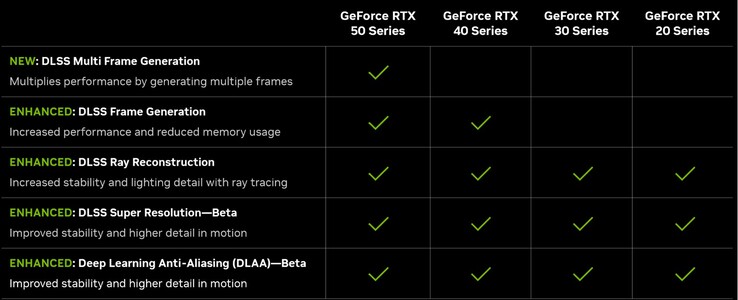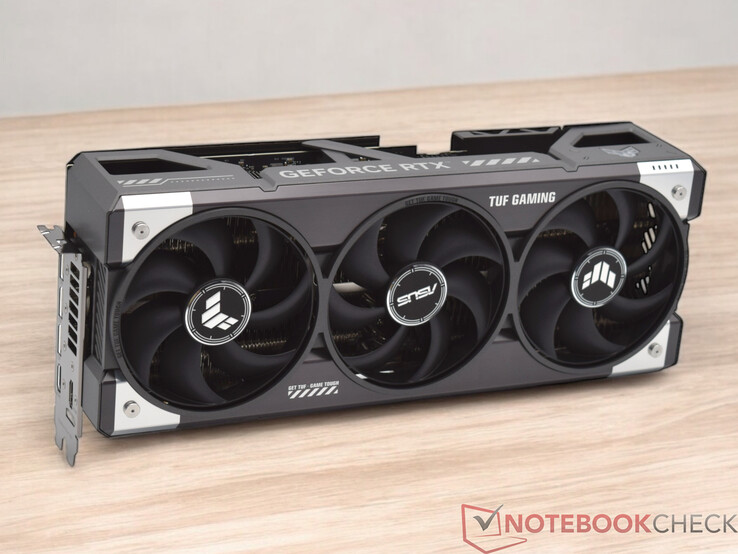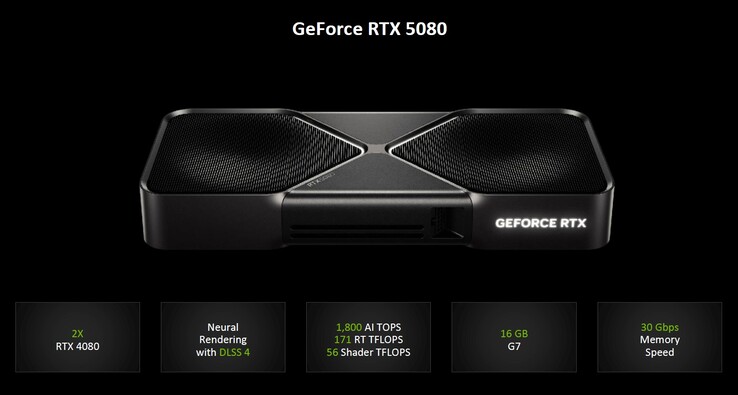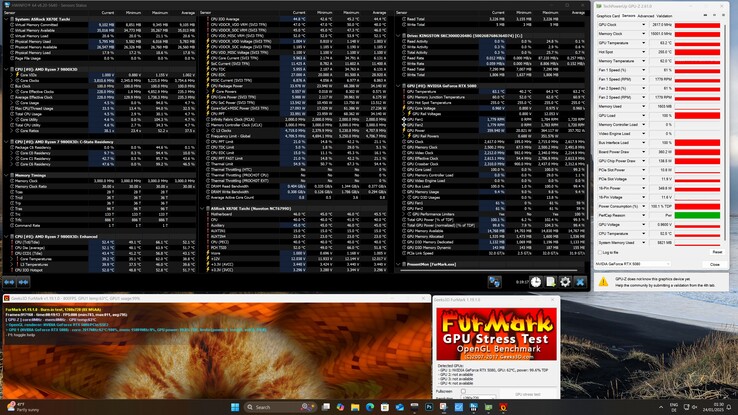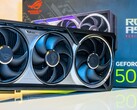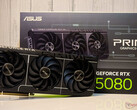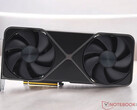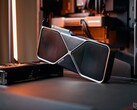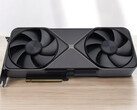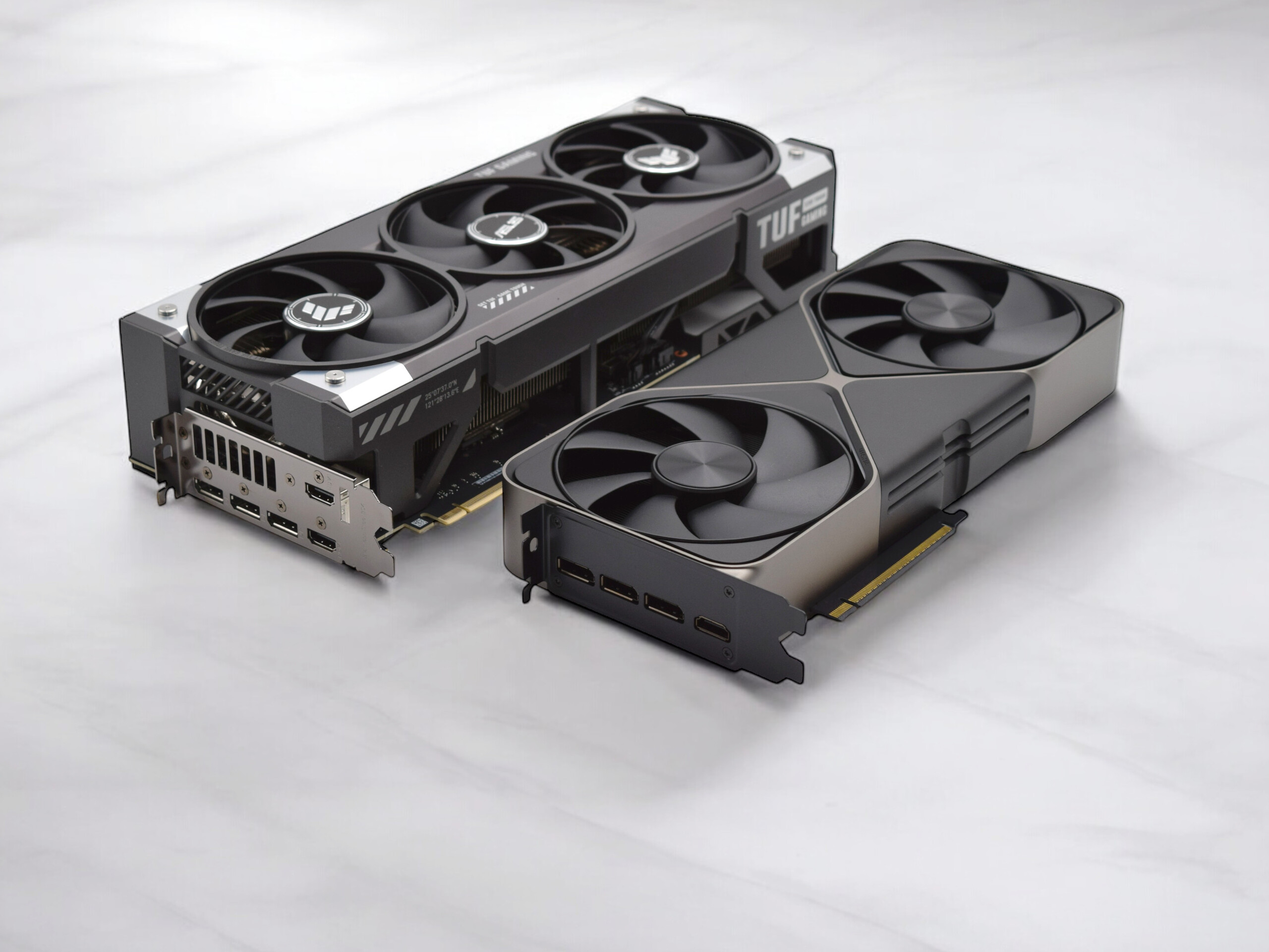
Asus TUF Gaming GeForce RTX 5080 OC review: Performance, cooling and efficiency of the Blackwell desktop GPU
No way of getting around AI!
As the first board partner model in Nvidia's Blackwell series, we take a detailed look at the Asus TUF Gaming GeForce RTX 5080 OC. Primarily, the Asus TUF Gaming GeForce RTX 5080 OC has to be compared against the Founders Edition. In this test, we examine how the Asus graphics card performs in current games with ray tracing using the latest features such as DLSS 4 and whether it lives up to its TUF Gaming name.Sebastian Bade, 👁 Sebastian Bade, ✓ Sebastian Jankowski (translated by DeepL / Ninh Duy) Published 🇩🇪 🇷🇺 ...
Verdict: Asus TUF Gaming GeForce RTX 5080 OC
The Asus TUF Gaming GeForce RTX 5080 OC delivers solid performance while incorporating the latest advancements from Nvidia’s Blackwell architecture. However, it shouldn’t be overhyped, as its raw performance gain over its predecessor is relatively modest. The GPU’s manufacturing process remains the same at 4nm, limiting the kind of leap seen with the RTX 4000 series. These physical constraints are unavoidable, even for Nvidia. To compensate, AI-powered enhancements have been significantly expanded, particularly with DLSS 4 and MFG. Unlike previous feature rollouts, where gamers had to wait for broad adoption, DLSS 4 is readily accessible on older GPUs. However, MFG (Multi-Frame Generation) remains exclusive to the RTX 5000 series, allowing the RTX 5080 OC to fully leverage its next-gen capabilities. This card shines where AI-driven performance boosts are integrated, showcasing the future of real-time rendering and upscaling. While the raw hardware improvements may seem incremental, the Asus TUF Gaming GeForce RTX 5080 OC proves that the next evolution of gaming isn’t just about brute force—it’s about intelligent performance optimization.
The biggest limitation of this graphics card is its VRAM. It only has 16GB, although the switch to GDDR7 has significantly improved speed. Despite this, there are scenarios where the GPU struggles, sometimes resulting in crashes. Lowering the resolution often helps considerably and is unavoidable in such cases.
The Asus TUF Gaming GeForce RTX 5080 OC is therefore ideal for QHD gaming at maximum settings. In some games, it can even handle 4K resolution without compromising detail. However, performance at 4K varies depending on the title, and further testing will be required to determine its true capabilities across different workloads.
Pros
Cons
Price and availability
In Germany, the RRP for the TUF Gaming GeForce RTX 5080 OC is €1,499. This represents a significant premium over the Founders Edition, which Nvidia lists at an RRP of €1,179.
Table of Contents
- Verdict: Asus TUF Gaming GeForce RTX 5080 OC
- Specifications
- Case and first impressions
- Performance - PCIe 5.0, but only 16GB VRAM
- Synthetic benchmarks
- Gaming performance
- Emissions - The power consumption increases to 360 watts
- Power consumption - Significant efficiency gains over Ada Lovelace and Ampere
- Notebookcheck overall rating
The Asus TUF Gaming GeForce RTX 5080 OC is a high-performance graphics card based on the GB203 graphics chip, making it the second-fastest consumer GPU built on Nvidia’s new Blackwell architecture. The Asus TUF series (The Ultimate Force) is well-established in the graphics card market, having accompanied multiple generations of GPUs, including the latest Blackwell models. Visually, TUF cards are known for their simple yet functional design, and the RTX 5080 OC is no exception, seamlessly integrating into the existing line-up.
From a technical standpoint, the Nvidia GeForce RTX 5080 offers the same feature set as the flagship (Nvidia GeForce RTX 5090), meaning there are no reductions in core functionality. However, a closer look at the specifications reveals clear differences in performance between the two models, which are immediately noticeable. More details on this will follow later in the review.
With the launch of Blackwell GPUs, many games will support new features such as DLSS and MFG (Multi-Frame Generation). Additionally, DLSS will transition to a Transformer model, benefiting even owners of older RTX graphics cards. However, Multi-Frame Generation will be exclusive to GeForce RTX 5000 series GPUs. If a game does not natively support MFG, users will still be able to enable it via the Nvidia app. According to Nvidia, there should be no performance difference between native support and activation through the app.
The design of the Asus TUF Gaming GeForce RTX 5080 OC differs significantly from the Nvidia GeForce RTX 5080 Founders Edition. Asus has retained the familiar TUF aesthetic, which remains a solid choice in our opinion.
Specifications
Case and first impressions
The Asus TUF Gaming GeForce RTX 5080 OC makes an immediate impression with its robust and well-crafted design as soon as it is unboxed. The exterior features a high-quality casing made from a mix of metal and plastic, while the reinforced aluminium backplate provides structural integrity and enhances heat dissipation.
Staying true to the TUF series aesthetic, the design is matte and understated, with subtle yet distinctive accents. RGB lighting is kept to a minimum (it's limited to the logo on the side of the card), adding a refined touch without appearing excessive. This restrained approach is set to appeal to gamers and content creators who prioritise functionality and durability over flashy aesthetics.
A key highlight is the cooling system, which utilises three large axial fans to generate strong airflow and efficiently draw in fresh air.
However, the sheer size of the graphics card should not be overlooked. Measuring just under 35 centimetres in length and occupying four slots in width, it may obstruct adjacent PCIe slots in some builds.
Overall, the Asus TUF Gaming GeForce RTX 5080 OC delivers an outstanding first impression, both in design and build quality.
Technical data in comparison
| Features | RTX 5090 (FE) | RTX 5080 (FE) | RTX 4090 (FE) | RTX 4080 (FE) | RTX 3090 Ti | RTX 3090 (FE) |
| Chip | GB202 | GB203 | AD102 | AD103 | GA102 | GA102 |
| FinFET process | 4 nm | 4 nm | 4 nm | 4 nm | 8 nm | 8 nm |
| CUDA Cores | 21760 | 10752 | 16384 | 9728 | 10752 | 10496 |
| Texture units | 680 | 336 | 512 | 304 | 336 | 328 |
| Tensor Cores | 680 5th Gen. | 336 5th Gen. | 512 4th Gen. | 304 4th Gen. | 336 3rd Gen. | 328 3rd Gen. |
| RT Cores | 170 | 84 | 128 | 76 | 84 | 82 |
| GPU Base Clock | 2010 MHz | 2295 MHz | 2235 MHz | 2205 MHz | 1560 MHz | 1395 MHz |
| GPU Boost Clock | 2407 MHz | 2617 MHz | 2520 MHz | 2505 MHz | 1860 MHz | 1695 MHz |
| Memory Bus | 512 bit | 256 bit | 384 bit | 256 bit | 384 bit | 384 bit |
| Memory bandwidth | 1792 GB/s | 960 GB/s | 1008 GB/s | 716.8 GB/s | 1008 GB/s | 936 GB/s |
| Video memory | 32 GB GDDR7 | 16 GB GDDR7 | 24 GB GDDR6X | 16 GB GDDR6X | 24 GB GDDR6X | 24 GB GDDR6X |
| TGP (Total Graphics Power) | 575 W | 360 W | 450 W | 320 W | 450 W | 350 W |
Performance - PCIe 5.0, but only 16GB VRAM
Like the Nvidia GeForce RTX 5090, the Nvidia GeForce RTX 5080 benefits from the technical advancements of the new Blackwell architecture. However, in terms of performance, the second-fastest model in the series shows a clear distinction from the flagship, as evident in the technical specifications.
The Nvidia GeForce RTX 5080 is the second-most powerful GPU in Nvidia’s Blackwell line-up. It features 10,752 CUDA cores, 16GB of GDDR7 memory, and a memory bandwidth of 960 GB/s.
One of its key highlights is support for DLSS 4 in combination with Multi-Frame Generation (MFG). This cutting-edge technology enhances visual realism by leveraging AI-powered frame generation and ray reconstruction, (supposedly) delivering superior display quality and smoother gameplay.
The Asus TUF Gaming GeForce RTX 5080 OC utilizes a PCIe 5.0 interface under optimal conditions. However, backward compatibility with older PCIe standards ensures that the latest Blackwell GPUs can still function with older motherboards.
Test conditions
For this test, we used an AMD Ryzen 7 9800X3D processor paired with an Asrock X870E Taichi motherboard. All performance benchmarks were conducted in the graphics card's Performance Mode (P-Mode).
As an alternative, the card also offers a Quiet Mode (Q-Mode), which adjusts the fan curve to reduce fan speed slightly. However, this mode does not affect the maximum power consumption or clock speeds of the graphics card.
Synthetic benchmarks
The Asus TUF Gaming GeForce RTX 5080 OC shows only a slight performance increase over the Nvidia GeForce RTX 4080 Super in synthetic benchmarks. When compared to the Nvidia GeForce RTX 5080 Founders Edition, our partner model narrowly comes out on top, but the difference is just two percentage points—a margin that is unlikely to be noticeable in real-world use.
Against the new flagship, the Nvidia GeForce RTX 5090 the RTX 5080 lags behind significantly. Even the Nvidia GeForce RTX 4090 maintains a clear lead, outperforming the RTX 5080 by 11 percentage points. In terms of competition from AMD, the Radeon RX 7900 XTX remains a strong contender, even against Nvidia’s second-fastest Blackwell model.
Despite these synthetic test results, benchmark scores do not always translate directly into real-world gaming or productivity performance. As always, actual performance will vary depending on factors such as game optimization, driver updates, and workload-specific demands.
| Performance rating - Percent | |
| Nvidia GeForce RTX 5090 Founders Edition | |
| Palit GeForce RTX 4090 GameRock OC | |
| Asus TUF Gaming GeForce RTX 5080 OC | |
| Nvidia GeForce RTX 5080 Founders Edition | |
| XFX Speedster MERC 310 Radeon RX 7900 XTX | |
| Average NVIDIA GeForce RTX 4080 Super -1! | |
| Nvidia GeForce RTX 3090 FE | |
| Unigine Superposition | |
| 7680x4320 8k Optimized | |
| Nvidia GeForce RTX 5090 Founders Edition | |
| Palit GeForce RTX 4090 GameRock OC | |
| Asus TUF Gaming GeForce RTX 5080 OC | |
| Nvidia GeForce RTX 5080 Founders Edition | |
| XFX Speedster MERC 310 Radeon RX 7900 XTX | |
| Average NVIDIA GeForce RTX 4080 Super (8729 - 8767, n=3) | |
| Nvidia GeForce RTX 3090 FE | |
| 3840x2160 4k Optimized | |
| Nvidia GeForce RTX 5090 Founders Edition | |
| Palit GeForce RTX 4090 GameRock OC | |
| Asus TUF Gaming GeForce RTX 5080 OC | |
| Nvidia GeForce RTX 5080 Founders Edition | |
| XFX Speedster MERC 310 Radeon RX 7900 XTX | |
| Average NVIDIA GeForce RTX 4080 Super (22985 - 23135, n=3) | |
| Nvidia GeForce RTX 3090 FE | |
| 1920x1080 1080p Extreme | |
| Nvidia GeForce RTX 5090 Founders Edition | |
| Palit GeForce RTX 4090 GameRock OC | |
| Asus TUF Gaming GeForce RTX 5080 OC | |
| Nvidia GeForce RTX 5080 Founders Edition | |
| XFX Speedster MERC 310 Radeon RX 7900 XTX | |
| Average NVIDIA GeForce RTX 4080 Super (16221 - 16971, n=3) | |
| Nvidia GeForce RTX 3090 FE | |
| Unigine Heaven 4.0 | |
| Extreme Preset DX11 | |
| Nvidia GeForce RTX 5090 Founders Edition | |
| Palit GeForce RTX 4090 GameRock OC | |
| Asus TUF Gaming GeForce RTX 5080 OC | |
| Nvidia GeForce RTX 5080 Founders Edition | |
| Average NVIDIA GeForce RTX 4080 Super (374 - 394, n=3) | |
| XFX Speedster MERC 310 Radeon RX 7900 XTX | |
| Nvidia GeForce RTX 3090 FE | |
| Extreme Preset OpenGL | |
| Nvidia GeForce RTX 5090 Founders Edition | |
| Palit GeForce RTX 4090 GameRock OC | |
| Asus TUF Gaming GeForce RTX 5080 OC | |
| Nvidia GeForce RTX 5080 Founders Edition | |
| XFX Speedster MERC 310 Radeon RX 7900 XTX | |
| Average NVIDIA GeForce RTX 4080 Super (370 - 386, n=3) | |
| Nvidia GeForce RTX 3090 FE | |
| Unigine Valley 1.0 | |
| 1920x1080 Extreme HD DirectX AA:x8 | |
| Palit GeForce RTX 4090 GameRock OC | |
| Nvidia GeForce RTX 5090 Founders Edition | |
| Nvidia GeForce RTX 5080 Founders Edition | |
| Asus TUF Gaming GeForce RTX 5080 OC | |
| XFX Speedster MERC 310 Radeon RX 7900 XTX | |
| Average NVIDIA GeForce RTX 4080 Super (269 - 282, n=3) | |
| Nvidia GeForce RTX 3090 FE | |
| 1920x1080 Extreme HD Preset OpenGL AA:x8 | |
| Nvidia GeForce RTX 5090 Founders Edition | |
| Palit GeForce RTX 4090 GameRock OC | |
| XFX Speedster MERC 310 Radeon RX 7900 XTX | |
| Asus TUF Gaming GeForce RTX 5080 OC | |
| Nvidia GeForce RTX 5080 Founders Edition | |
| Average NVIDIA GeForce RTX 4080 Super (269 - 274, n=3) | |
| Nvidia GeForce RTX 3090 FE | |
| Affinity Photo 2 - Combined (Single / Multi GPU) | |
| XFX Speedster MERC 310 Radeon RX 7900 XTX | |
| Palit GeForce RTX 4090 GameRock OC | |
| Nvidia GeForce RTX 5080 Founders Edition | |
| Asus TUF Gaming GeForce RTX 5080 OC | |
| Nvidia GeForce RTX 5090 Founders Edition | |
| Nvidia GeForce RTX 3090 FE | |
| Average NVIDIA GeForce RTX 4080 Super (8399 - 8557, n=2) | |
| V-Ray Benchmark Next 4.10 - GPU | |
| Nvidia GeForce RTX 5090 Founders Edition (v4.10.07 ) | |
| Palit GeForce RTX 4090 GameRock OC (v4.10.07 ) | |
| Asus TUF Gaming GeForce RTX 5080 OC (v4.10.07 ) | |
| Nvidia GeForce RTX 5080 Founders Edition (v4.10.07 ) | |
| Average NVIDIA GeForce RTX 4080 Super (1471 - 1492, n=2) | |
| Nvidia GeForce RTX 3090 FE (v4.10.07 ) | |
| XFX Speedster MERC 310 Radeon RX 7900 XTX (v4.10.07 ) | |
| Blender | |
| v3.3 Classroom CUDA | |
| Nvidia GeForce RTX 3090 FE | |
| Asus TUF Gaming GeForce RTX 5080 OC | |
| Nvidia GeForce RTX 5080 Founders Edition | |
| Palit GeForce RTX 4090 GameRock OC | |
| Nvidia GeForce RTX 5090 Founders Edition | |
| v3.3 Classroom OPTIX/RTX | |
| Nvidia GeForce RTX 3090 FE | |
| Asus TUF Gaming GeForce RTX 5080 OC | |
| Nvidia GeForce RTX 5080 Founders Edition | |
| Palit GeForce RTX 4090 GameRock OC | |
| Nvidia GeForce RTX 5090 Founders Edition | |
| MLPerf Client 0.5 - overall generation rate | |
| Nvidia GeForce RTX 5090 Founders Edition | |
| Palit GeForce RTX 4090 GameRock OC | |
| Asus TUF Gaming GeForce RTX 5080 OC | |
| Nvidia GeForce RTX 5080 Founders Edition | |
| XFX Speedster MERC 310 Radeon RX 7900 XTX | |
| Nvidia GeForce RTX 3090 FE | |
| Geekbench AI | |
| Single Precision ONNX DirectML GPU 1.2 | |
| Nvidia GeForce RTX 5090 Founders Edition | |
| Palit GeForce RTX 4090 GameRock OC | |
| Asus TUF Gaming GeForce RTX 5080 OC | |
| Nvidia GeForce RTX 5080 Founders Edition | |
| XFX Speedster MERC 310 Radeon RX 7900 XTX | |
| Nvidia GeForce RTX 3090 FE | |
| Half Precision ONNX DirectML GPU 1.2 | |
| Nvidia GeForce RTX 5090 Founders Edition | |
| Asus TUF Gaming GeForce RTX 5080 OC | |
| Nvidia GeForce RTX 5080 Founders Edition | |
| Palit GeForce RTX 4090 GameRock OC | |
| XFX Speedster MERC 310 Radeon RX 7900 XTX | |
| Nvidia GeForce RTX 3090 FE | |
| Quantized ONNX DirectML GPU 1.2 | |
| Nvidia GeForce RTX 5090 Founders Edition | |
| Palit GeForce RTX 4090 GameRock OC | |
| XFX Speedster MERC 310 Radeon RX 7900 XTX | |
| Asus TUF Gaming GeForce RTX 5080 OC | |
| Nvidia GeForce RTX 5080 Founders Edition | |
| Nvidia GeForce RTX 3090 FE | |
* ... smaller is better
Professional application performance
Our test unit falls well behind the Nvidia GeForce RTX 5090 in overall performance. However, for semi-professional workloads, the RTX 5080 can still be a viable option, as it delivers adequate performance in SPECviewperf 2020.
In the latest SPECworkstation 4.0 test, the performance gap between GPUs narrows, though the general ranking remains unchanged. Interestingly, AMD once again stands out as a strong choice for professional applications, with the Radeon RX 7900 XTX setting the benchmark in this category.
However, hardware compatibility with specific software is crucial for maximizing performance. In professional environments, dedicated workstation GPUs—equipped with specialized drivers—are generally the best choice for ensuring stability and full software optimization.
| Asus TUF Gaming GeForce RTX 5080 OC R7 9800X3D | Nvidia GeForce RTX 5080 Founders Edition R7 9800X3D | Nvidia GeForce RTX 5090 Founders Edition R7 9800X3D | Palit GeForce RTX 4090 GameRock OC R7 9800X3D | Nvidia GeForce RTX 3090 FE R7 9800X3D | XFX Speedster MERC 310 Radeon RX 7900 XTX R7 9800X3D | |
|---|---|---|---|---|---|---|
| SPECviewperf 2020 | -1% | 36% | 12% | -34% | 69% | |
| 3840x2160 Medical (medical-03) (fps) | 34.8 | 33.7 -3% | 51.2 47% | 43.4 25% | 21.1 -39% | 107 207% |
| 3840x2160 Maya (maya-06) (fps) | 565 | 558 -1% | 697 23% | 610 8% | 363 -36% | 565 0% |
| 3840x2160 Energy (energy-03) (fps) | 115 | 113 -2% | 196 70% | 138 20% | 56.4 -51% | 194 69% |
| 3840x2160 Creo (creo-03) (fps) | 130 | 129 -1% | 136 5% | 133 2% | 114 -12% | 223 72% |
| 3840x2160 CATIA (catia-06) (fps) | 82.5 | 81.7 -1% | 109 32% | 89.9 9% | 59.3 -28% | 149 81% |
| 3840x2160 3ds Max (3dsmax-07) (fps) | 217 | 216 0% | 297 37% | 235 8% | 139 -36% | 187 -14% |
| SPECworkstation 4.0 | -0% | 11% | 3% | -17% | 23% | |
| Graphics Score (Points) | 9.16 | 9.04 -1% | 11.2 22% | 9.9 8% | 6.19 -32% | 14.1 54% |
| AI & Machine Learning Score (Points) | 1.21 | 1.2 -1% | 1.18 -2% | 1.2 -1% | 1.2 -1% | 1.22 1% |
| Viewport Graphics (Points) | 9.16 | 9.04 -1% | 11.2 22% | 9.9 8% | 6.19 -32% | 14.1 54% |
| HandBrake (Points) | 1.84 | 1.85 1% | 1.85 1% | 1.82 -1% | 1.72 -7% | 1.92 4% |
| ONNX Inference (Points) | 4.13 | 4.15 0% | 4.65 13% | 4.23 2% | 3.69 -11% | 4.21 2% |
| Total Average (Program / Settings) | -1% /
-1% | 24% /
25% | 8% /
8% | -26% /
-26% | 46% /
48% |
Gaming performance
The Asus TUF Gaming GeForce RTX 5080 OC delivers more than enough power to handle modern games, but its performance varies depending on the title. A closer look reveals that VRAM limitations can become a bottleneck, as the card's 16GB of memory is only half that of the flagship model.
A clear example of this is Indiana Jones and the Great Circle, which repeatedly crashed in 4K with DLSS and full path tracing, highlighting the VRAM issue is real. We were unable to complete benchmarks in this case, though even the Nvidia GeForce RTX 4080 struggled, managing just 17 FPS. The RTX 5080 likely wouldn’t have fared much better. However, this issue was not observed in other games during testing, making Indiana Jones and the Great Circle more of an outlier than a general trend.
For those considering the Asus TUF Gaming GeForce RTX 5080 OC, choosing the right display is equally important. The card is primarily designed for QHD (1440p) and UHD (4K) gaming, but 4K gaming could become increasingly challenging over time—especially when relying solely on rasterisation performance. Upscaling technologies like DLSS may be necessary to maintain smooth frame rates at higher resolutions.
| Performance rating - Percent | |
| Nvidia GeForce RTX 5090 Founders Edition | |
| Palit GeForce RTX 4090 GameRock OC | |
| Asus TUF Gaming GeForce RTX 5080 OC | |
| Nvidia GeForce RTX 5080 Founders Edition | |
| XFX Speedster MERC 310 Radeon RX 7900 XTX | |
| Nvidia GeForce RTX 3090 FE | |
| The Witcher 3 - 3840x2160 Ultra Graphics & Postprocessing (HBAO+) | |
| Nvidia GeForce RTX 5090 Founders Edition | |
| Palit GeForce RTX 4090 GameRock OC | |
| Asus TUF Gaming GeForce RTX 5080 OC | |
| Nvidia GeForce RTX 5080 Founders Edition | |
| XFX Speedster MERC 310 Radeon RX 7900 XTX | |
| Nvidia GeForce RTX 3090 FE | |
| Hogwarts Legacy - 3840x2160 Ultra Preset AA:High T | |
| Nvidia GeForce RTX 5090 Founders Edition | |
| Palit GeForce RTX 4090 GameRock OC | |
| Asus TUF Gaming GeForce RTX 5080 OC | |
| Nvidia GeForce RTX 5080 Founders Edition | |
| XFX Speedster MERC 310 Radeon RX 7900 XTX | |
| Nvidia GeForce RTX 3090 FE | |
| Baldur's Gate 3 - 3840x2160 Ultra Preset AA:T | |
| Nvidia GeForce RTX 5090 Founders Edition | |
| Palit GeForce RTX 4090 GameRock OC | |
| Asus TUF Gaming GeForce RTX 5080 OC | |
| Nvidia GeForce RTX 5080 Founders Edition | |
| XFX Speedster MERC 310 Radeon RX 7900 XTX | |
| Nvidia GeForce RTX 3090 FE | |
| Cyberpunk 2077 - 3840x2160 Ultra Preset (FSR off) | |
| Nvidia GeForce RTX 5090 Founders Edition | |
| Palit GeForce RTX 4090 GameRock OC | |
| Nvidia GeForce RTX 5080 Founders Edition | |
| Asus TUF Gaming GeForce RTX 5080 OC | |
| XFX Speedster MERC 310 Radeon RX 7900 XTX | |
| Nvidia GeForce RTX 3090 FE | |
| Alan Wake 2 - 3840x2160 High Preset | |
| Nvidia GeForce RTX 5090 Founders Edition | |
| Palit GeForce RTX 4090 GameRock OC | |
| XFX Speedster MERC 310 Radeon RX 7900 XTX | |
| Asus TUF Gaming GeForce RTX 5080 OC | |
| Nvidia GeForce RTX 5080 Founders Edition | |
| Nvidia GeForce RTX 3090 FE | |
| F1 24 - 3840x2160 Ultra High Preset AA:T AF:16x | |
| Nvidia GeForce RTX 5090 Founders Edition | |
| Palit GeForce RTX 4090 GameRock OC | |
| Asus TUF Gaming GeForce RTX 5080 OC | |
| Nvidia GeForce RTX 5080 Founders Edition | |
| XFX Speedster MERC 310 Radeon RX 7900 XTX | |
| Nvidia GeForce RTX 3090 FE | |
| Black Myth: Wukong - 3840x2160 cinematic TSR 100 | |
| Nvidia GeForce RTX 5090 Founders Edition | |
| Palit GeForce RTX 4090 GameRock OC | |
| Asus TUF Gaming GeForce RTX 5080 OC | |
| Nvidia GeForce RTX 5080 Founders Edition | |
| XFX Speedster MERC 310 Radeon RX 7900 XTX | |
| Nvidia GeForce RTX 3090 FE | |
| Star Wars Outlaws - 3840x2160 cinem. ultra | |
| Nvidia GeForce RTX 5090 Founders Edition | |
| Palit GeForce RTX 4090 GameRock OC | |
| Asus TUF Gaming GeForce RTX 5080 OC | |
| Nvidia GeForce RTX 5080 Founders Edition | |
| XFX Speedster MERC 310 Radeon RX 7900 XTX | |
| Nvidia GeForce RTX 3090 FE | |
| Call of Duty Black Ops 6 - 3840x2160 Extreme Preset | |
| Nvidia GeForce RTX 5090 Founders Edition | |
| XFX Speedster MERC 310 Radeon RX 7900 XTX | |
| Palit GeForce RTX 4090 GameRock OC | |
| Asus TUF Gaming GeForce RTX 5080 OC | |
| Nvidia GeForce RTX 5080 Founders Edition | |
| Nvidia GeForce RTX 3090 FE | |
| Stalker 2 - 3840x2160 Epic Preset | |
| Nvidia GeForce RTX 5090 Founders Edition | |
| Palit GeForce RTX 4090 GameRock OC | |
| Asus TUF Gaming GeForce RTX 5080 OC | |
| Nvidia GeForce RTX 5080 Founders Edition | |
| XFX Speedster MERC 310 Radeon RX 7900 XTX | |
| Nvidia GeForce RTX 3090 FE | |
| Indiana Jones and the Great Circle - 3840x2160 Very Ultra Preset | |
| Nvidia GeForce RTX 5090 Founders Edition | |
| Palit GeForce RTX 4090 GameRock OC | |
| Asus TUF Gaming GeForce RTX 5080 OC | |
| Nvidia GeForce RTX 5080 Founders Edition | |
| XFX Speedster MERC 310 Radeon RX 7900 XTX | |
| Nvidia GeForce RTX 3090 FE | |
DLSS 4 and Multi Frame Generation (MFG)
When looking at pure raster performance, Nvidia’s Blackwell GPUs do not deliver a substantial lead over the Ada Lovelace generation. However, Nvidia has significantly improved and revamped key technologies, including DLSS and Frame Generation (FG).
With the switch to the Transformer model (DLSS 4), image quality is noticeably enhanced without impacting performance. In combination with FG and Multi-Frame Generation (MFG)—which is exclusive to Blackwell GPUs—frame rates can be massively boosted.
The Asus TUF Gaming GeForce RTX 5080 OC offers a slight advantage over the Founders Edition, despite using the same GPU chip. However, when compared to the Nvidia GeForce Nvidia GeForce RTX 5090 FE our test unit still trails by a significant margin.
When comparing native gaming performance to DLSS 4 with MFG enabled, the difference is staggering. With MFG activated, the RTX 5080 OC can achieve a 4x performance boost over the RTX 4090.
Of course, this comparison has its limitations, as the Ada Lovelace flagship lacks support for these new technologies, making it an uneven fight. That said, subjectively, the Asus TUF Gaming GeForce RTX 5080 OC delivers smooth frame rates, even with AI-powered enhancements enabled, as confirmed by P1 frame time values and overall gameplay experience.
| Cyberpunk 2077 | |
| 3840x2160 Ray Tracing Overdrive Preset + DLSS 4 Transformer Quality (no FG) | |
| Nvidia GeForce RTX 5090 Founders Edition | |
| Palit GeForce RTX 4090 GameRock OC | |
| Nvidia GeForce RTX 5080 Founders Edition | |
| Asus TUF Gaming GeForce RTX 5080 OC | |
| Nvidia GeForce RTX 3090 FE | |
| 3840x2160 Ray Tracing Overdrive Preset + DLSS 4 Transformer Quality + Frame Generation (M)FG 2x | |
| Nvidia GeForce RTX 5090 Founders Edition | |
| Palit GeForce RTX 4090 GameRock OC | |
| Asus TUF Gaming GeForce RTX 5080 OC | |
| Nvidia GeForce RTX 5080 Founders Edition | |
| 3840x2160 Ray Tracing Overdrive Preset + DLSS 4 Transformer Quality + Frame Generation MFG 4x | |
| Nvidia GeForce RTX 5090 Founders Edition | |
| Asus TUF Gaming GeForce RTX 5080 OC | |
| Nvidia GeForce RTX 5080 Founders Edition | |
| Alan Wake 2 | |
| 3840x2160 High Preset + Ultra Ray Tracing + Quality DLSS | |
| Nvidia GeForce RTX 5090 Founders Edition | |
| Palit GeForce RTX 4090 GameRock OC | |
| Asus TUF Gaming GeForce RTX 5080 OC | |
| Nvidia GeForce RTX 5080 Founders Edition | |
| Nvidia GeForce RTX 3090 FE | |
| 3840x2160 High Preset + Ultra Ray Tracing + Quality DLSS + FG 2x | |
| Nvidia GeForce RTX 5090 Founders Edition | |
| Palit GeForce RTX 4090 GameRock OC | |
| Asus TUF Gaming GeForce RTX 5080 OC | |
| Nvidia GeForce RTX 5080 Founders Edition | |
| 3840x2160 High Preset + Ultra Ray Tracing + Quality DLSS + FG 4x | |
| Nvidia GeForce RTX 5090 Founders Edition | |
| Asus TUF Gaming GeForce RTX 5080 OC | |
| Nvidia GeForce RTX 5080 Founders Edition | |
| Star Wars Outlaws | |
| 3840x2160 cinem. ultra, RT ultra, DLSS, FG RR | |
| Nvidia GeForce RTX 5090 Founders Edition | |
| Palit GeForce RTX 4090 GameRock OC | |
| Asus TUF Gaming GeForce RTX 5080 OC | |
| Nvidia GeForce RTX 5080 Founders Edition | |
| 3840x2160 cinem. ultra, RT ultra, DLSS, FG 4x, RR | |
| Nvidia GeForce RTX 5090 Founders Edition | |
| Asus TUF Gaming GeForce RTX 5080 OC | |
| Nvidia GeForce RTX 5080 Founders Edition | |
| Hogwarts Legacy | |
| 3840x2160 Ultra Preset + Full Ray Tracing + DLSS4 Quality + FG 2x AA:High T | |
| Nvidia GeForce RTX 5090 Founders Edition | |
| Palit GeForce RTX 4090 GameRock OC | |
| Asus TUF Gaming GeForce RTX 5080 OC | |
| Nvidia GeForce RTX 5080 Founders Edition | |
| 3840x2160 Ultra Preset + Full Ray Tracing + DLSS4 Quality + FG 4x AA:High T | |
| Nvidia GeForce RTX 5090 Founders Edition | |
| Asus TUF Gaming GeForce RTX 5080 OC | |
| Nvidia GeForce RTX 5080 Founders Edition | |
Overview of the games tested with Asus TUF Gaming GeForce RTX 5080 OC
| low | med. | high | ultra | QHD DLSS | QHD | 4K DLSS | 4K | |
|---|---|---|---|---|---|---|---|---|
| Kingdom Come Deliverance 2 (2025) | 377 | 294 | 245 | 165.4 | 162.6 | 127.1 | 106.4 | 73.5 |
| Monster Hunter Wilds (2025) | 152.9 | 137 | 113.6 | 109.2 | 93.3 | 80.7 | 60.7 | |
| Civilization 7 (2025) | 324 | 280 | 275 | 232 | 133.9 | |||
| Assassin's Creed Shadows (2025) | 138 | 126 | 110 | 82 | 83 | 70 | 76 | 54 |
| The Elder Scrolls IV Oblivion Remastered (2025) | 204 | 191.5 | 140.1 | 70.9 | 75.2 | 53 | 50.9 | 32.6 |
| Doom: The Dark Ages (2025) | 170.1 | 151.5 | 142.2 | 137.5 | 132.8 | 103.8 | 89.1 | 61.6 |
| F1 25 (2025) | 404 | 391 | 366 | 79.5 | 85.9 | 49.7 | 45.2 | 23.9 |
| Borderlands 4 (2025) | 129.8 | 110.5 | 93.4 | 66.9 | 69.9 | 49.1 | 144.9 | 28.2 |
| Battlefield 6 (2025) | 284 | 261 | 228 | 175.6 | 158.4 | 129.1 | 102.5 | 74.7 |
| The Outer Worlds 2 (2025) | 192.4 | 171.1 | 142.1 | 99.1 | 72.1 | 70.2 | 57.1 | 39.3 |
| ARC Raiders (2025) | 367 | 268 | 217 | 148.6 | 145.6 | 114 | 102.6 | 70.1 |
| Anno 117: Pax Romana (2025) | 233.6 | 178.2 | 133.7 | 87 | 88.4 | 64.6 | 58.7 | 37.8 |
| Call of Duty Black Ops 7 (2025) | 252 | 205 | 88 | 90 | 62 | 53 | 36 |
Emissions - The power consumption increases to 360 watts
Noise emissions
Asus has equipped the TUF Gaming GeForce RTX 5080 OC with a high-performance cooling system. The card features three Axial-Tech fans, designed to provide optimal airflow and keep temperatures in check.
In practice, this means the fans remain inactive in 2D mode and only spin at low speeds under light loads. During idle or low-intensity tasks, we measured just 30.3 dB(A) in an open test bench setup, making the card virtually silent.
However, under stress testing, noise levels increase to 42.3 dB(A). While this is not excessively loud, the presence of coil whine is a noticeable drawback, as it remains clearly audible throughout operation.
Noise level
| Idle |
| 27.9 / 28 / 28 dB(A) |
| Load |
| 30.3 / 42.3 dB(A) |
 | ||
30 dB silent 40 dB(A) audible 50 dB(A) loud |
||
min: | ||
Temperature
The Asus TUF Gaming GeForce RTX 5080 OC employs a different cooling approach than the Founders Edition, making the two graphics cards fundamentally different in terms of heat dissipation. Asus uses a large heatsink with a vapor chamber, combined with three Axial-Tech fans to push fresh air through the cooling fins for efficient thermal management.
Asus also promotes its MaxContact technology, which is designed to provide an ultra-smooth contact surface between the cooler and the GPU chip, ensuring better heat transfer. However, we were unable to verify this claim, as we did not disassemble the graphics card during testing.
The large heatsink is sufficient to handle the GPU’s full 360W TGP. During stress testing, we recorded a peak temperature of 64.3°C for the GPU core, while VRAM temperatures remained slightly lower at 62°C. Unfortunately, we were unable to measure the GPU hotspot temperature, and it remains unclear whether Nvidia will enable this in future updates. Having access to this data would be valuable, as it could help detect potential heat transfer issues caused by material ageing over time.
Asus takes a different approach to thermal materials compared to Nvidia’s Founders Edition, which utilizes liquid metal for improved conductivity. Instead, our test unit features a phase-change thermal pad, which is designed to be just as durable while avoiding the potential drawbacks of traditional thermal paste. This should ensure long-term stability without the risks associated with liquid metal application.
Power consumption - Significant efficiency gains over Ada Lovelace and Ampere
Fortunately, the Asus TUF Gaming GeForce RTX 5080 OC does not set any new records for power consumption. However, Nvidia has increased the TGP slightly compared to the GeForce RTX 4080, raising it from 320W to 360W. This increase is less dramatic than that of the series flagship, which pushes power consumption up to 575W—a new high for Nvidia GPUs.
In our testing, the Asus TUF Gaming GeForce RTX 5080 OC showed power draw comparable to the Nvidia GeForce RTX 3090. When considering performance per watt, this represents a significant improvement in efficiency over previous generations. However, with a peak consumption of 487W in stress tests and around 450W in gaming, the RTX 5080 OC is far from being an energy-efficient GPU.
For those planning to install the second-fastest GPU in the Blackwell series, Asus recommends a power supply of at least 850W. Adhering to these specifications is crucial to ensure stable and reliable system performance under load.
| Power Consumption / FurMark 1.19 GPU Stress Test (external Monitor) | |
| Nvidia GeForce RTX 5090 Founders Edition, AMD Ryzen 7 9800X3D | |
| Palit GeForce RTX 4090 GameRock OC, AMD Ryzen 7 9800X3D | |
| XFX Speedster MERC 310 Radeon RX 7900 XTX, AMD Ryzen 7 9800X3D | |
| Asus TUF Gaming GeForce RTX 5080 OC, AMD Ryzen 7 9800X3D | |
| Nvidia GeForce RTX 3090 FE, AMD Ryzen 7 9800X3D | |
| Nvidia GeForce RTX 5080 Founders Edition, AMD Ryzen 7 9800X3D | |
| Power Consumption / The Witcher 3 ultra (external Monitor) | |
| Nvidia GeForce RTX 5090 Founders Edition, AMD Ryzen 7 9800X3D | |
| XFX Speedster MERC 310 Radeon RX 7900 XTX, AMD Ryzen 7 9800X3D | |
| Palit GeForce RTX 4090 GameRock OC, AMD Ryzen 7 9800X3D | |
| Nvidia GeForce RTX 3090 FE, AMD Ryzen 7 9800X3D | |
| Asus TUF Gaming GeForce RTX 5080 OC, AMD Ryzen 7 9800X3D | |
| Nvidia GeForce RTX 5080 Founders Edition, AMD Ryzen 7 9800X3D | |
| Power Consumption / Cyberpunk 2077 FHD ultra no FSR (external Monitor) | |
| Nvidia GeForce RTX 5090 Founders Edition, AMD Ryzen 7 9800X3D | |
| Palit GeForce RTX 4090 GameRock OC, AMD Ryzen 7 9800X3D | |
| XFX Speedster MERC 310 Radeon RX 7900 XTX, AMD Ryzen 7 9800X3D | |
| Nvidia GeForce RTX 3090 FE, AMD Ryzen 7 9800X3D | |
| Asus TUF Gaming GeForce RTX 5080 OC, AMD Ryzen 7 9800X3D | |
| Nvidia GeForce RTX 5080 Founders Edition, AMD Ryzen 7 9800X3D | |
| Power Consumption / Witcher 3 ultra Efficiency (external Monitor) | |
| Nvidia GeForce RTX 5080 Founders Edition, AMD Ryzen 7 9800X3D | |
| Asus TUF Gaming GeForce RTX 5080 OC, AMD Ryzen 7 9800X3D | |
| Palit GeForce RTX 4090 GameRock OC, AMD Ryzen 7 9800X3D | |
| Nvidia GeForce RTX 5090 Founders Edition, AMD Ryzen 7 9800X3D | |
| XFX Speedster MERC 310 Radeon RX 7900 XTX, AMD Ryzen 7 9800X3D | |
| Nvidia GeForce RTX 3090 FE, AMD Ryzen 7 9800X3D | |
* ... smaller is better
Power consumption - external monitor
Notebookcheck overall rating
The Asus TUF Gaming GeForce RTX 5080 OC is a high-performance graphics card that delivers a notable FPS boost with Nvidia’s new Blackwell architecture, provided its latest features are utilised.
Asus stays true to its signature TUF design, ensuring that this GPU integrates seamlessly into the TUF series line-up. However, owners of high-end Ada Lovelace cards need not worry—the raw performance gain over the previous generation is relatively modest. The biggest advantages of the Blackwell architecture come from its new technologies, which enable a significant FPS boost in supported games and applications.
Transparency
The selection of devices to be reviewed is made by our editorial team. The test sample was given to the author by the manufacturer free of charge for the purposes of review. There was no third-party influence on this review, nor did the manufacturer receive a copy of this review before publication. There was no obligation to publish this review. As an independent media company, Notebookcheck is not subjected to the authority of manufacturers, retailers or publishers.
This is how Notebookcheck is testing
Every year, Notebookcheck independently reviews hundreds of laptops and smartphones using standardized procedures to ensure that all results are comparable. We have continuously developed our test methods for around 20 years and set industry standards in the process. In our test labs, high-quality measuring equipment is utilized by experienced technicians and editors. These tests involve a multi-stage validation process. Our complex rating system is based on hundreds of well-founded measurements and benchmarks, which maintains objectivity. Further information on our test methods can be found here.




